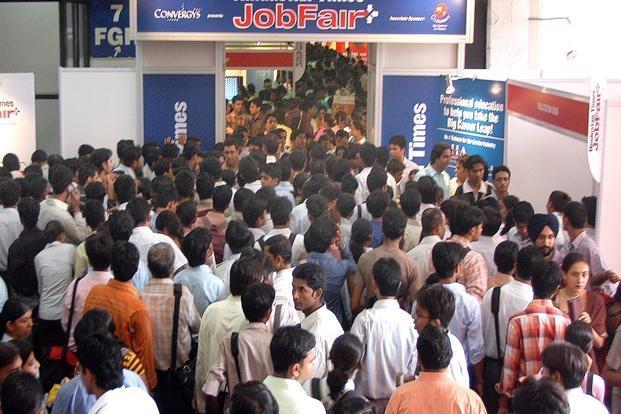3 years of Modi Government: Where are the Jobs?

In the whole of last year, just 2.3 lakh jobs were added in eight key non-farm sectors of the economy ranging, according to a recent govt. report. These eight sectors are manufacturing, construction, trade, transport, accommodation & restaurants, IT/BPO, education and health. All together, they employ over 2 cr workers. So, the addition of new jobs amounts to a mere 1.1% of the total.
Remember: Narendra Modi himself, and all his associates in the government had promised the people of India that tackling unemployment by creating jobs will be the biggest priority of their government. They had promised that their much tom-tommed programs like ‘Make in India’, ‘Skill India’, ‘Startup India’ and others would resolve the joblessness that haunts India and set the country on the path of prosperity. Modi had in fact justified his kowtowing to foreign investors by saying that their investments will create jobs.
Now, three years down the line all this has vanished in thin year. Modi, Jaitley, et al are no longer talking about creating jobs. All the schemes are forgotten. They are just concentrating on winning elections and thinking up new tricks to fool the people like removing red lights from VIP cars or visiting temples to pray. Meanwhile people across the country are wondering – what happened to all the promises of jobs?
Reports from the rural job guarantee scheme (MGNREGS) indicate that unemployment continues unabated and in fact it seems to be worsening. In Modi’s first year as Prime Minister, 4.65 crore households demanded work in the scheme. Next year, in 2015-16, this number had increased 15% to reach 5.35 crore. Then, in 2016-17, it further increased by 6% to reach a staggering 5.69 crore households in search of work.
Even as the demand for low paying work in MGNREGS increases, 10-11% of applicants are not given jobs. According to govt. data, last year nearly 58 lakh households that wanted work in the scheme were turned back.
In the current financial year 2017-18, only 35 days have passed but the number of households demanding work has already crossed 1.38 crore. This is despite the fact that last year’s monsoon was much better than the preceding years.
As per the latest report, increase in new jobs is not only very slow but also that it is highly imbalanced. For instance almost half of the 2.1 lakh new jobs added are in two sectors – education and health which together added 1.1 lakh new jobs.
Growth in manufacturing jobs is recorded as being just short of 1%, and that too because of a sudden increase in the last quarter of 2016. This in itself is highly suspect because it was in this period that the disastrous demonetization was imposed on the country, with consequent job losses.
Manufacturing sector is the backbone of the non-farm economy and employs nearly half of the workers in the selected eight sectors. A mere one percent growth is virtually nothing for this massive sector. This is despite the fact that it was the target of attention by the Modi govt. through its ‘Make in India’ and ‘Skill India’ programs, as also of efforts to woo foreign direct investment. It is clear that all this has failed spectacularly.
The failure of Indian capitalist class to invest more in manufacturing, coupled with reluctance of foreign capital to invest in productive work in India, means that not only are new jobs not being created but existing ones are being cut on a country-wide scale. This is leading to a worsening of the job situation, forget about improvement. Several recent reports by industry analysts indicate that IT, telecom and the banking & financial services sectors which have been the main job creators in recent years are now getting rid of their workforce. One report says that these three sectors will throw out at least 10 lakh employees in the coming 12-18 months because of a slowing economy, mergers among telecom giants and automation. Many of the startups – much applauded by Modi – are folding up or demanding more concessions to survive
.
Even foreign analysts, who otherwise do not tire of praising Modi, are worried about the lack of job growth. Over 30% of youth aged 15-29 in India are not in employment, education or training (NEETs), according to a recent report by the Organisation of Economic Cooperation and Development (OECD), an organization of advanced capitalist countries. This is more than double the OECD average of 14.6% and almost three times that of China (11.2%).
Although the govt. has been patting itself on the back for the projected high GDP growth rate for India, the nuts and bolts of the economy are all in deep freeze. This is why there is no growth in jobs.
The Index of Industrial Production (IIP) released monthly by the govt. confirms this dire situation with a rise of a mere one percent between January 2015 and January 2017.
According to latest data from the Reserve Bank of India, the same period saw gross bank credit to industries increasing by a mere 0.3%. This includes credit disbursals to micro, small, medium and large industries and together makes up nearly 40% of all non-food credit. The meager increase in credit to industry is a symptom of the flagging growth in manufacturing which is also reflected in lack of jobs growth.
Further confirmation of the languishing manufacturing sector comes from second advanced estimates of national income and expenditure released by the govt. last month. Growth in investment in fixed capital known as gross fixed capital formation dipped by a factor of 10 between 2015-16 and 2016-17 from 6.1% to a shocking 0.6% in 2016-17. This implies that the corporate sector is not investing in new production arrangements.
Growth in gross value added (GVA) at basic prices – a measure of actual production – has slipped from 7.8% in 2015-16 to 6.7% in 2016-17. This is yet another confirmation that the economy is not too well. And hence the flagging growth in jobs.
Disclaimer: The views expressed here are the author's personal views, and do not necessarily represent the views of Newsclick.
Get the latest reports & analysis with people's perspective on Protests, movements & deep analytical videos, discussions of the current affairs in your Telegram app. Subscribe to NewsClick's Telegram channel & get Real-Time updates on stories, as they get published on our website.























